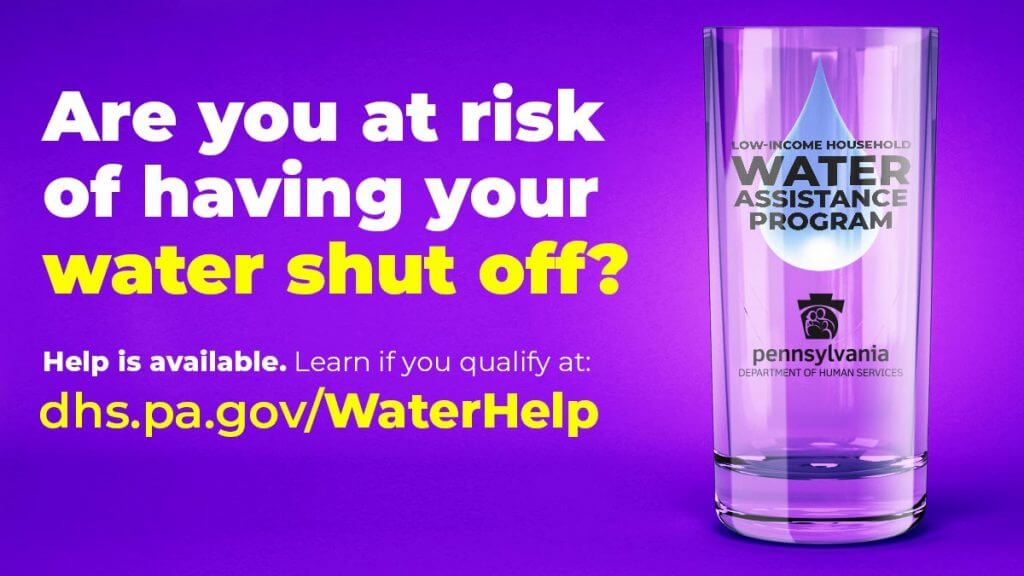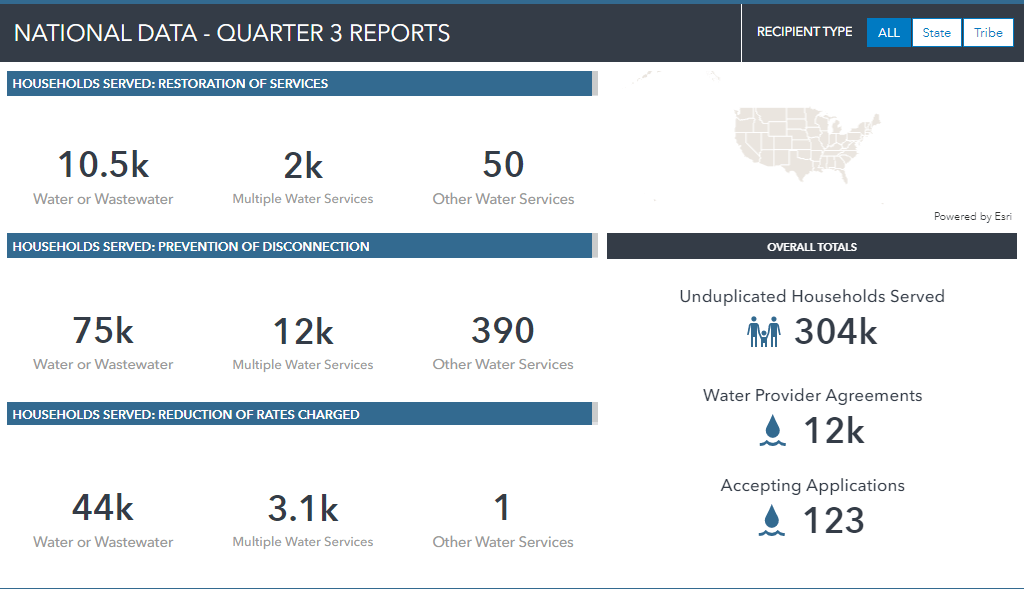Low-Income Household Water Assistance Program Check-In
LIHWAP, the Low-Income Household Water Assistance Program created and funded through emergency Covid-19 legislation in December 2020 (Consolidated Appropriations Act (CAA)) and March 2021 (ARPA (American Rescue Plan Act)), is the first national water assistance program of its kind. We previously covered some of the basics of the program and an update on how the first round of implementation data provided by states through quarterly reports demonstrated the successes and challenges of the program. You can check out that blog post here.
Congress authorized LIHWAP as an emergency program, and it’s set to expire in the fall of 2023. After putting in so much effort to stand up a new program, the Department of Health and Human Services (HHS) faces the possibility of wrapping up this critically important program as the need for water assistance continues to grow across the country. Efforts to channel further funding to the HHS program remain stagnant. Advocates have also been keeping an eye on the opportunity to appropriate money to the thus-unfunded Environmental Protection Agency (EPA) water affordability pilot program created through the bipartisan infrastructure law (BIL), but traction on funding for this program remains to be seen. For now, LIHWAP stands to be sunset in 2023 leaving many households at risk of losing access to running water in their homes due to inability to pay their costly water bills.
Current Roll Out of LIHWAP
HHS’ Administration for Children and Families’ Office of Community Services (OCS) administers LIHWAP funding to states. Households may apply for assistance to restore disconnected water services, prevent pending disconnections of water services, and/or to reduce rates for their current water bills.
Quarterly reports provide important insights into the roll out of LIHWAP. Quarters 1, 2, and 3 are now available on HHS’ website. In the first three quarters, the program served over 304,000 households, with over 85,000 households able to get their service restored or disconnection prevented. Unfortunately, some states and tribal grantees have obligated all or nearly all their funding. While there may be a year left for the program to operate, it will wrap up much earlier for some, showing the immense need for comprehensive solutions to address water affordability and provide assistance services to households struggling to make ends meet. On the opposite end of the spectrum, some states are lagging and have not yet begun implementing the program, in part due to limited staff capacity and a lack of technological support to accept applications, including Alaska and New Hampshire.
The Data Dashboard pulls information from quarterly reports that grant recipients and subrecipients are required to provide to HHS. It includes information from states, DC, territories, and Tribes. Quarter 3 data shows that there are now 11,666 water service provider agreements- up from around 5,000 after the first quarter, yet miniscule in proportion to the total number of water service providers country-wide (over 50,000). When water and wastewater service providers don’t participate in LIHWAP, their customers aren’t able to access services. When asked what their primary challenges are with program administration, state agencies repeatedly brought up low water system participation.
“A challenge that many of the agencies have reported is not being able to assist those households in which the local water supplier have chosen not to enroll with the state.” – Georgia Department of Human Services
“The biggest challenge remains vendors who have opted not to participate in the program by choice or because of local ordinances related to customer shutoff protections in the MOU.” – Michigan Health and Human Services
Some states are continuing to streamline the application process by approving combined LIHWAP and Low-Income Heating Assistance Program (LIHEAP) applications to reduce the number of forms people need to fill out. Other states like New Jersey have started “auto-qualifying” customers who receive other benefits from low-income assistance programs and sending staff to events to help enroll customers who may have difficulty doing so online.
Pennsylvania Set to End LIHWAP as Last Funds Go Out the Door
The need for ongoing federal assistance for water access is tremendous and is glaringly obvious in states that have already distributed their LIHWAP funding nearly a year before the program is scheduled to end. Pennsylvania is set to wrap up their LIHWAP program early since funds have been completely used up. Around 28,000 cumulative households benefited from the program. For more context, we reached out to the Pennsylvania Utility Law Project, an organization representing low-income consumers in water and wastewater rate proceedings and working to ensure consumers can maintain access to affordable utility services. Executive Director Elizabeth Marx explained that from the beginning, LIHWAP funding was inadequate to address the needs of Pennsylvanian households who struggled to keep up with rising water costs exacerbated by the Covid-19 pandemic. The state received $43.2 million in LIHWAP funding, but residential consumer debt from the three largest Public Utility Commission-regulated utilities alone ramped up to over $51 million by February 2021. With around 3,000 water and wastewater systems throughout the state, the combining forces of water privatization, removal of contaminants, and infrastructure investment have resulted in increasing costs for folks living in rural, suburban, and urban areas.
According to Elizabeth Marx, “Many low-income families now regularly pay well over 10% – and often over 20% – of household income on water and wastewater services alone – leaving very little left to pay for other expenses. Together with energy costs that often exceed 30% of household income, many are just not able to keep up … and that doesn’t include the astronomically high housing and rental costs.” While ratepayer supported assistance programs are being stood up in Pennsylvania, they create a patchwork of assistance offerings that don’t bring down water and wastewater burdens statewide.
“Many low-income families now regularly pay well over 10% – and often over 20% – of household income on water and wastewater services alone – leaving very little left to pay for other expenses.” – Elizabeth Marx, Pennsylvania Utility Law Project
From the perspective of Pennsylvania Utility Law Project, a service program portfolio should include 1) rate discount programs based on a percentage of household income, 2) arrearage management programs to provide debt forgiveness for customers making regular payments on discounted bills, 3) grant assistance programs to provide hardship fund assistance to households and crisis relief to stop water shutoffs, and 4) conservation and efficiency programs to help reduce usage and leaks.

How Should a National Water Assistance Program Work?
This is a question many folks are putting their heads together on, in different circles. The Center for Water Security and Cooperation (CWSC) and DigDeep convened a Community Task Force on Water Equity to develop recommendations for a permanent national household water assistance program. Their recommendations center on the premise that “Water is a public good and should be held in public trust. Water and sanitation are human rights. Access to clean, safe, and affordable water is not a privilege and should not be denied to households.” Their report outlines assistance program objectives and metrics of success that they hope will be considered in a future permanent federal assistance program.
What’s your experience with LIHWAP? How do you think a national water assistance program should work, and who should administer it? Let us know in the comments or join a monthly Drinking Water Access Exchange call to share your thoughts.
-
[…] Low-Income Household Water Assistance Program Check-In, Oct 2022 […]
[…] Low-Income Household Water Assistance Program Check-In, Oct 2022 […]
Leave a Comment






Thank you for highlighting LIHWAP and the work being done across the country. Just wanted to let you know what Florida, Hawaii, Maine, Nevada, South Dakota, Virginia, and Wyoming have all begun implementing the program and are accepting applications!
Thank you, Rachel! I’ve updated the sentence to remove those states, glad to hear they are now implementing the program.
The Office of Community Services updated the LIHWAP data dashboard with Q4 data on 12/12/22, which includes info from July 1-Sept 30. They also published a 2 page “snapshot”.
As of September 30th, 2022, over 13,000 water and wastewater service providers are participating in LIHWAP. LIHWAP grant recipients have obligated over 70% of existing funding. Several grant recipients have exhausted all current funding.
An annual report will be forthcoming in 2023. https://www.acf.hhs.gov/ocs/policy-guidance/lihwap-q4-updates-and-annual-snapshot-fy2023